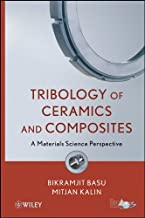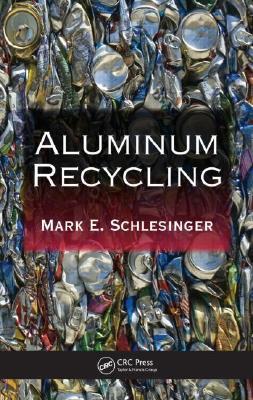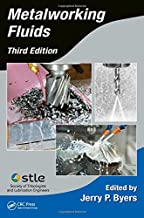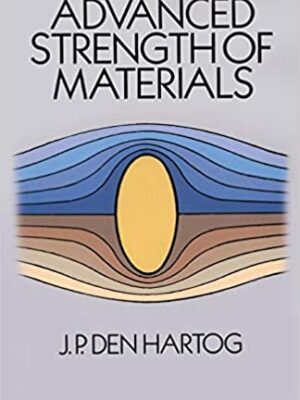Tribology of Ceramics & Composites: A Materials Science Perspective
Original price was: ₹14,586.94.₹11,669.55Current price is: ₹11,669.55.
ISBN: 9780470522639
Author/Editor: Bikramjit Basu
Publisher: John Wiley
Year: 2011
1 in stock (can be backordered)
Description
This book helps students and practicing scientists alike understand that a comprehensive knowledge about the friction and wear properties of advanced materials is essential to further design and development of new materials. With important introductory chapters on the fundamentals, processing, and applications of tribology, the book then examines in detail the nature and properties of materials, the friction and wear of structural ceramics, bioceramics, biocomposites, and nanoceramics, as well as lightweight composites and the friction and wear of ceramics in a cryogenic environment.
Additional information
| Weight | 0.868 kg |
|---|
Product Properties
| Year of Publication | 2011 |
|---|---|
| Table of Contents | PREFACE xvii FOREWORD BY PROF. IAN HUTCHINGS xxi FOREWORD BY PROF. KARL-HEINZ ZUM GAHR xxiii ABOUT THE AUTHORS xxv SECTION I FUNDAMENTALS CHAPTER 1 INTRODUCTION 3 References 6 CHAPTER 2 OVERVIEW: TRIBOLOGICAL MATERIALS 7 2.1 Introduction 7 2.2 Definition and Classification of Ceramics 8 2.3 Properties of Structural Ceramics 9 2.4 Applications of Structural Ceramics 11 2.5 Closing Remarks 14 References 16 CHAPTER 3 OVERVIEW: MECHANICAL PROPERTIES OF CERAMICS 18 3.1 Theory of Brittle Fracture 18 3.2 Cracking in Brittle Materials 23 3.3 Definition and Measurement of Basic Mechanical Properties 24 3.4 Toughening Mechanisms 33 3.5 Closing Remarks 37 References 37 CHAPTER 4 SURFACES AND CONTACTS 39 4.1 Surface Roughness 39 4.2 Surface Topography and Asperities 41 4.3 Real Contact Area 42 4.4 Contact Load Distribution and Hertzian Stresses 44 4.5 Closing Remarks 47 References 48 CHAPTER 5 FRICTION 49 5.1 Introduction 49 5.2 Laws of Friction 49 5.3 Friction Mechanisms 51 5.4 Friction of Common Engineering Materials 54 5.5 Closing Remarks 58 References 59 CHAPTER 6 FRICTIONAL HEATING AND CONTACT TEMPERATURE 60 6.1 Tribological Process and Contact Temperature 60 6.2 Concept of Bulk and Flash Temperature 61 6.3 Importance and Relevance of Some Ready-to-Use Analytical Models 63 6.4 Review of Some Frequently Employed Ready-to-Use Models 64 References 68 CHAPTER 7 WEAR MECHANISMS 70 7.1 Introduction 70 7.2 Classification of Wear Mechanisms 72 7.3 Closing Remarks 98 References 99 CHAPTER 8 LUBRICATION 101 8.1 Lubrication Regimes 101 8.2 Stribeck Curve 107 References 109 SECTION II FRICTION AND WEAR OF STRUCTURAL CERAMICS CHAPTER 9 OVERVIEW: STRUCTURAL CERAMICS 113 9.1 Introduction 113 9.2 Zirconia Crystal Structures and Transformation Characteristics of Tetragonal Zirconia 114 9.3 Transformation Toughening 116 9.4 Stabilization of Tetragonal Zirconia 117 9.5 Different Factors Infl uencing Transformation Toughening 118 9.6 Stress-Induced Microcracking 125 9.7 Development of SiAlON Ceramics 126 9.8 Microstructure of S-sialon Ceramics 127 9.9 Mechanical Properties and Crack Bridging of SiAlON Ceramic 129 9.10 Properties of Titanium Diboride Ceramics 132 References 138 CHAPTER 10 CASE STUDY: TRANSFORMATION-TOUGHENED ZIRCONIA 142 10.1 Background 142 10.2 Wear Resistance 144 10.3 Morphological Characterization of the Worn Surfaces 146 10.4 Zirconia Phase Transformation and Wear Behavior 149 10.5 Wear Mechanisms 152 10.6 Relationship among Microstructure, Toughness, and Wear 154 10.7 Infl uence of Humidity on Tribological Properties of Self-Mated Zirconia 156 10.8 Wear Mechanisms in Different Humidity 157 10.9 Tribochemical Wear in High Humidity 160 10.10 Closing Remarks 163 References 164 CHAPTER 11 CASE STUDY: SIALON CERAMICS 167 11.1 Introduction 167 11.2 Materials and Experiments 168 11.3 Tribological Properties of Compositionally Tailored Sialon versus -Sialon 172 11.4 Tribological Properties of S-Sialon Ceramic 179 11.5 Concluding Remarks 182 References 183 CHAPTER 12 CASE STUDY: MAX PHASE TI3SIC2 185 12.1 Background 185 12.2 Frictional Behavior 188 12.3 Wear Resistance and Wear Mechanisms 188 12.4 Raman Spectroscopy and Atomic Force Microscopy Analysis 190 12.5 Transition in Wear Mechanisms 193 12.6 Summary 194 References 195 CHAPTER 13 CASE STUDY: TITANIUM DIBORIDE CERAMICS AND COMPOSITES 197 13.1 Introduction 197 13.2 Materials and Experiments 198 13.3 Tribological Properties of TiB2 MoSi2 Ceramics 200 13.4 Tribological Properties of TiB2 TiSi2 Ceramics 204 13.5 Closing Remarks 206 References 208 SECTION III FRICTION AND WEAR OF BIOCERAMICS AND BIOCOMPOSITES CHAPTER 14 OVERVIEW: BIOCERAMICS AND BIOCOMPOSITES 213 14.1 Introduction 213 14.2 Some Useful Definitions and Their Implications 215 14.3 Experimental Evaluation of Biocompatibility 217 14.4 Wear of Implants 221 14.5 Coating on Metals 223 14.6 Glass-Ceramics 224 14.7 Biocompatible Ceramics 226 14.8 Outlook 228 References 229 CHAPTER 15 CASE STUDY: POLYMER-CERAMIC BIOCOMPOSITES 233 15.1 Introduction 233 15.2 Materials and Experiments 235 15.3 Frictional Behavior 237 15.4 Wear-Resistance Properties 240 15.5 Wear Mechanisms 242 15.6 Correlation among Wear Resistance, Wear Mechanisms, Material Properties, and Contact Pressure 247 15.7 Concluding Remarks 248 References 249 CHAPTER 16 CASE STUDY: NATURAL TOOTH AND DENTAL RESTORATIVE MATERIALS 251 16.1 Introduction 251 16.2 Materials and Methods 254 16.3 Tribological Tests on Tooth Material 255 16.4 Production and Characterization of Glass-Ceramics 255 16.5 Wear Experiments on Glass-Ceramics 256 16.6 Microstructure and Hardness of Human Tooth Material 257 16.7 Tribological Properties of Human Tooth Material 260 16.8 Wear Properties of Glass-Ceramics 262 16.9 Discussion of Wear Mechanisms of Glass-Ceramics 266 16.10 Comparison with Existing Glass-Ceramic Materials 271 16.11 Concluding Remarks 273 References 274 CHAPTER 17 CASE STUDY: GLASS-INFILTRATED ALUMINA 276 17.1 Introduction 276 17.2 Materials and Experiments 277 17.3 Frictional Properties 278 17.4 Wear Resistance and Wear Mechanisms 278 17.5 Wear Debris Analysis and Tribochemical Reactions 282 17.6 Influence of Glass Infi ltration on Wear Properties 283 17.7 Concluding Remarks 284 References 285 CHAPTER 18 TRIBOLOGICAL PROPERTIES OF CERAMIC BIOCOMPOSITES 287 18.1 Background 287 18.2 Tribological Properties of Mullite-Reinforced Hydroxyapatite 288 18.3 Friction and Wear Rate 288 18.4 Concluding Remarks 298 References 302 SECTION IV FRICTION AND WEAR OF NANOCERAMICS CHAPTER 19 OVERVIEW: NANOCERAMIC COMPOSITES 307 19.1 Introduction 307 19.2 Processing of Bulk Nanocrystalline Ceramics 309 19.3 Overview of Developed Nanoceramics and Ceramic Nanocomposites 309 19.4 Overview of Tribological Properties of Ceramic Nanocomposites 318 19.5 Concluding Remarks 320 References 322 CHAPTER 20 CASE STUDY: NANOCRYSTALLINE YTTRIA-STABILIZED TETRAGONAL ZIRCONIA POLYCRYSTALLINE CERAMICS 325 20.1 Introduction 325 20.2 Materials and Experiments 327 20.3 Tribological Properties 329 20.4 Tribomechanical Wear of Yttria-Stabilized Zirconia Nanoceramic with Varying Yttria Dopant 330 20.5 Comparison with Other Stabilized Zirconia Ceramics 335 20.6 Concluding Remarks 335 References 336 CHAPTER 21 CASE STUDY: NANOSTRUCTURED TUNGSTEN CARBIDE ZIRCONIA NANOCOMPOSITES 338 21.1 Introduction 338 21.2 Materials and Experiments 339 21.3 Friction and Wear Characteristics 340 21.4 Wear Mechanisms 345 21.5 Explanation of High Wear Resistance of Ceramic Nanocomposites 347 21.6 Concluding Remarks 349 References 349 SECTION V LIGHTWEIGHT COMPOSITES AND CERMETS CHAPTER 22 OVERVIEW: LIGHTWEIGHT METAL MATRIX COMPOSITES AND CERMETS 353 22.1 Development of Metal Matrix Composites 353 22.2 Development of Cermets 356 References 358 CHAPTER 23 CASE STUDY: MAGNESIUM SILICON CARBIDE PARTICULATEREINFORCED COMPOSITES 362 23.1 Introduction 362 23.2 Materials and Experiments 363 23.3 Load-Dependent Friction and Wear Properties 363 23.4 Fretting-Duration-Dependent Tribological Properties 366 23.5 Tribochemical Wear of Magnesium Silicon Carbide Particulate-Reinforced Composites 371 23.6 Concluding Remarks 375 References 376 CHAPTER 24 CASE STUDY: TITANIUM CARBONITRIDE NICKELBASED CERMETS 377 24.1 Introduction 377 24.2 Materials and Experiments 379 24.3 Energy Dissipation and Abrasion at Low Load 381 24.4 Influence of Type of Secondary Carbides on Sliding Wear of Titanium Carbonitride Nickel Cermets 386 24.5 Tribochemical Wear of Titanium Carbonitride Based Cermets 387 24.6 Influence of Tungsten Carbide Content on Load-Dependent Sliding Wear Properties 393 24.7 High Temperature Wear of Titanium Carbonitride Nickel Cermets 397 24.8 Summary of Key Results 403 References 404 CHAPTER 25 CASE STUDY: (W,Ti)C CO CERMETS 407 25.1 Introduction 407 25.2 Materials and Experiments 408 25.3 Microstructure and Mechanical Properties 409 25.4 Wear Properties 410 25.5 Correlation between Mechanical Properties and Wear Resistance 413 25.6 Concluding Remarks 418 References 419 SECTION VI FRICTION AND WEAR OF CERAMICS IN A CRYOGENIC ENVIRONMENT CHAPTER 26 OVERVIEW: CRYOGENIC WEAR PROPERTIES OF MATERIALS 423 26.1 Background 423 26.2 Designing a High-Speed Cryogenic Wear Tester 425 26.3 Summary of Results Obtained with Ductile Metals 427 26.4 Summary 437 References 437 CHAPTER 27 CASE STUDY: SLIDING WEAR OF ALUMINA IN A CRYOGENIC ENVIRONMENT 439 27.1 Background 439 27.2 Materials and Experiments 440 27.3 Tribological Properties of Self-Mated Alumina 442 27.4 Genesis of Tribological Behavior in a Cryogenic Environment 449 27.5 Concluding Remarks 452 References 452 CHAPTER 28 CASE STUDY: SLIDING WEAR OF SELF-MATED TETRAGONAL ZIRCONIA CERAMICS IN LIQUID NITROGEN 454 28.1 Introduction 454 28.2 Materials and Experiments 456 28.3 Friction of Self-Mated Y-TZP Material in LN2 456 28.4 Cryogenic Wear of Zirconia 459 28.5 Cryogenic Sliding-Induced Zirconia Phase Transformation 460 28.6 Wear Mechanisms of Zirconia in LN2 464 28.7 Concluding Remarks 466 References 467 CHAPTER 29 CASE STUDY: SLIDING WEAR OF SILICON CARBIDE IN A CRYOGENIC ENVIRONMENT 469 29.1 Introduction 469 29.2 Materials and Experiments 470 29.3 Friction and Wear Properties 470 29.4 Thermal Aspect and Limited Tribochemical Wear 473 29.5 Tribomechanical Stress-Assisted Deformation and Damage 479 29.6 Comparison with Sliding Wear Properties of Oxide Ceramics 481 29.7 Concluding Remarks 482 References 483 SECTION VII WATER-LUBRICATED WEAR OF CERAMICS CHAPTER 30 FRICTION AND WEAR OF OXIDE CERAMICS IN AN AQUEOUS ENVIRONMENT 487 30.1 Background 487 30.2 Tribological Behavior of Alumina in an Aqueous Solution 488 30.3 Tribological Behavior of Self-Mated Zirconia in an Aqueous Environment 493 30.4 Concluding Remarks 499 References 500 SECTION VIII CLOSURE CHAPTER 31 PERSPECTIVE FOR DESIGNING MATERIALS FOR TRIBOLOGICAL APPLICATIONS 505 INDEX 509 |
| Author | Bikramjit Basu |
| ISBN/ISSN | 9780470522639 |
| Binding | Hardback |
| Edition | 1 |
| Publisher | John Wiley |
You must be logged in to post a review.






Reviews
There are no reviews yet.